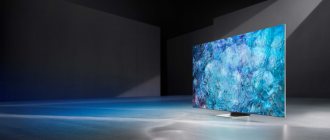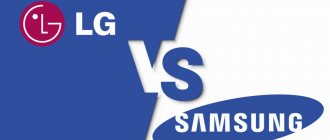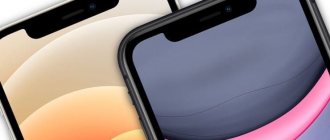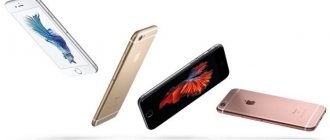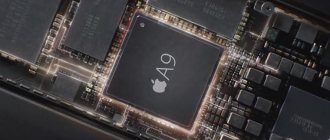The Samsung and Sony brands are known throughout the world. Their TVs are popular, but each brand has its supporters and opponents. If you compare models from both companies, you can understand that they have a lot in common, but there are also differences, which we will look into.
Both companies are direct competitors of each other, which annually release updated models and even TV lines. The wealth of choice only complicates the purchase when you need good equipment at a reasonable cost. The comparative analysis will help highlight the features of each brand and make the right choice.
Pros and cons of Sony TVs
The Japanese brand is very popular and successful in the market; it produces mobile phones, cameras and other popular equipment, which can be attributed to the company’s big advantages. The main disadvantage of TVs from this manufacturer is the inflated price. Sony does not produce models in the budget price segment at all.
Modern TVs are created using the most advanced technologies, but often users simply cannot appreciate them in reality due to lack of content, low Internet speed or poor-quality TV signal. It's obvious that you're overpaying for unnecessary features.
In terms of build quality, Sony TVs have always been ahead. It is produced in Slovakia and Malaysia.
There are several more advantages of this brand’s TV equipment:
- Numerous image processing – perfect picture;
- High quality dynamic scenes without flickering, delays or distortion;
- Clear detailed image;
- Powerful sound, often the presence of a subwoofer;
- Wide viewing angle without distortion;
- Real deep black color;
- Uniform Direct LED illumination;
- 3D support (in older models);
- OS Android.
Among the disadvantages, the following can be noted:
- Overpriced even for models from previous years;
- Russian buyers really won’t be able to appreciate 80% of the TV’s capabilities;
- One-year warranty, the extension of which must be paid for;
- No QLED screens;
- Inconvenient remote control with no instructions.
Feel the difference
Samsung and Sony are well-known TV manufacturers with an army of consumers around the world. It may seem to the average buyer that there are no big differences between them. However, when buying a new TV, it is important to understand that along with getting benefits, you have to sacrifice something. Even TVs from the most popular brands can differ significantly from each other in such parameters as supported formats, panel technology and manufacturing methods, case and stand materials. While Sony and Samsung's TVs have more similarities than differences - they're just TV boxes, after all - both manufacturers are keen to stand out in a saturated market. If you are already looking at Sony and Samsung technology, we will try to explain the difference between them in this article.
Pros and cons of Samsung TVs
The South Korean brand entered the market earlier than its opponent, and it is more consumer-oriented than Sony. TV models satisfy buyers with price and functionality. TV equipment is assembled in Russia, the build quality is high, and the products last for decades. All equipment parts are manufactured and designed at company factories, that is, the full production cycle is covered.
One of the important differences between Samsung and its competitor is the production of goods in different price categories. Budget options are in no way inferior to premium models in image quality. Display diagonals for every taste - from 19'' and above.
Samsung has its own Tizen operating system. Most modern models support voice and even gesture control.
It is worth noting other advantages of Samsung TVs:
- Realistic color rendering;
- Clear touch remote control;
- Uniform illumination makes viewing comfortable even in a brightly lit room;
- Contrasting image;
- Decent sound from the built-in audio system;
- Many models with curved screen;
- Wide viewing angle.
There are also disadvantages:
- One-year warranty, which can be extended to 2 years for an additional fee;
- OLED screens are not produced;
- High power consumption.
LG C1 OLED vs LG CX OLED. Which TV is better?
The LG C1 OLED replaces the LG CX OLED and generally very similar TVs. The biggest differences are that the C1 has an 83-inch screen option, the latest version of webOS, and includes new game optimization settings that reduce input lag by a few milliseconds. The C1 has color accuracy issues and has lower brightness than the CX, but the color accuracy issue may be resolved with future software updates (previously this happened with other models at launch). If none of the minor additions are significant to you, then the LG CX OLED is a good option for less.
Comparison of Sony and Samsung TVs by main characteristics
Having briefly studied the advantages and disadvantages of a particular brand, it is difficult to make a final decision about which TV is better. Therefore, it is important to evaluate the main characteristics of the product, take into account the opinions of experts and not ignore real reviews from product buyers.
Design
The peculiarity of Sony TVs is their classic design, which has not changed for a very long time. Frameless models are very similar to Samsung, but differ in the stands. This is a choice for those who like simplicity without frills.
Samsung has a different design policy. Ultra-modern televisions with frames of different shapes, sizes and colors regularly appear on the shelves. The shape of the case itself is also different, not to mention the stands.
Both companies strive to minimize the frames and thereby increase the diagonal. There will be no significant differences in the design of TVs from opposing companies. The metal edging protects the display from accidental impacts, so its presence or excessive thickness should not be considered a disadvantage.
Diagonal
Sony produces TVs with a diagonal of at least 32'' and up to 85''. Samsung offers consumers models with a minimum diagonal of 19'' and up to 98''. The Koreans win here because their catalog has different options for every taste and budget. Screens of innovative models from Sony with a full range of technologies and functions are not produced smaller than 55''.
4K HDR TVs do not limit the distance from the user; they can be viewed almost closely.
Picture quality
The user is unlikely to notice the difference in picture quality if he compares two competing TVs of the same price category. Sony comes out a little ahead due to its HDR image processing technology, but this difference is only noticeable when conducting a light test.
Both companies are trying to produce high-resolution displays, so they practically no longer produce HD TVs, but they are still found in the budget segment of Samsung. Brands are more focused on creating 4K and . Full HD screens remain especially popular, this is explained by the reasonable price of such equipment.
If you compare competitors' products based on picture quality, the result will be ambiguous. Both brands will pass shade testing successfully, but Sony's anibrec system works better.
The realism of color reproduction is better in Samsung, but its competitor has excessively high saturation, and the brightness is slightly higher than normal, but this contrast is good for evening movie watching. The driving dynamics are well conveyed in both brands, but the highest indicator is in Korean premium vehicles.
The results of various tests indicate that Samsung TVs have a high motion transmission speed and a wide range of settings, which is important when choosing a model to connect a game console.
Sony is not far behind, and the new 2022 TVs with Football Match mode provide improved images that allow you to clearly see all the details of the sporting event. There is no trailing, no jitter, or any other distortion. Interaction with new generation game consoles also works well.
There are no significant differences at this point; experts recommend focusing on high resolution when choosing.
Matrix
Both companies use a liquid crystal LED matrix with LED backlighting. But the manufacturing methods are different. Sony uses only high-end VA matrices, so the brand does not have PLS or PVA displays. This adds to the cost of production, but the screen displays a bright, true-to-life image and is free from distortion when viewed from any angle. Thanks to the HDR system, both the dark and lightest areas of the image are equally visible on the screen.
Samsung most often uses PLS and PVA matrices. Because of this, the viewing angle is somewhat limited and the perspective is distorted when watching TV at a long distance. But the new QLED models use Ultra Viewing Angle technology, which greatly improves picture quality when viewed at an angle.
The Japanese win here because they do not waste their time on trifles. Of these, OLED TVs are the best option. Thanks to thousands of LEDs, light transmission is increased, natural colors are produced, and the picture is clear and realistic.
QLED production technology is somewhat behind OLED, but their price is much more attractive. The best way to choose a matrix is to evaluate it with your own eyes in a store. If this is not possible, then choose an OLED TV.
Sound
There will be no losers in the sound competition - both brands are at a high level. You need to choose according to the purpose of the TV - to watch TV channels, Dolby Digital from Sony is enough, and for more powerful sound, Samsung has models with several pairs of speakers and subwoofers. To get professional stereo sound, you will have to additionally connect external speakers.
3D support
Both companies moved away from 3D technology due to the fact that it simply became irrelevant, but there are still “old” models on sale that support active or passive 3D and they are sold complete with glasses. These are models from 2011-2015.
Remote Control
Samsung wins here, since Sony is “famous” for its clunky remote controls, which take a long time to understand. And the menu itself is not ideal either. The remote control often slows down, and the TV takes a long time to process its signal. There are a lot of extra buttons that are simply not used, and working with Smart TV is not very convenient.
With Samsung it’s the other way around – a laconic, easy-to-understand remote control, and in expensive models there’s even a touchscreen one.
Additional functions
The equipment and functionality largely depend on the price of the TV. Both companies offer customers models with 3D support, Wi-Fi and Smart TV function. Sony interacts perfectly with tablets and smartphones, does not “slow down” or freeze during operation.
Samsung is pleased with its intuitive interface, understandable even to the elderly or children. But the work of pre-installed applications is sometimes unstable. Sony's optimization is better, but the opponent is not far behind.
Also, depending on the year of manufacture, cost and configuration, such functions may be available:
- voice and gesture control;
- curved screen;
- teletext;
- additional installed applications.
Some Sony TV models even support Google Assistant.
Smart TV platform
Sony TV platform based on Android TV
Both brands use a different smart platform with their own features. Samsung installs Tizen OS on mid-range and higher-category TVs. The platform provides easy navigation and is not overloaded. A regularly updated recent views window lets you quickly find your most used apps. Overall, the platform deserves a good rating, although the universal search button is not as convenient as LG's webOS. Sony uses Android TV OS, which is more loaded than its competitor. This platform is a little more complex, but provides more options. Conclusion: choosing an operating system is a matter of personal preference. We add that the Android TV OS is more prone to crashes than other television platforms. When it comes to voice assistant, Sony's premium models offer Google Assistant built-in, which makes sense given that Android TV is a Google-developed platform. Sony offers Amazon Alexa Music and a camera and TV control app in its 2022 lineup. This provides control of third-party devices and speakers through Alexa and allows you to use voice commands to turn on the TV and adjust the volume. Samsung's Bixby voice assistant is available on mid-range and higher-end TVs. However, it is inferior to Alexa and Google Assistant in terms of the number of functions and quality of voice recognition. But it is quite enough for minimal control of the TV. If you wish, you can connect your Samsung TV to Alexa.
Price
If you compare similar good models from Samsung and Sony, you will notice that the product from the second manufacturer will cost much more than the first. The choice of TV equipment from Sony is not very large, so if you need a medium-priced or inexpensive TV, then it is better to look at Samsung’s offers.
To summarize, we note that the choice will most likely come down to cost, because both companies have high-quality pictures, good sound and high technology. Samsung produces a large line of TV equipment, satisfying all the needs of users with any budget. And that's the only reason why Sony might end up behind.
Sony has an expensive VA matrix and advanced HDR, but Samsung has advanced backlight technology and an Edge LED and Direct LED system. It turns out that the South Koreans have learned to get a good picture from a cheap matrix and have overtaken their competitors. The expensive matrix cannot be improved, and the price of the product is appropriate, which scares off buyers.
LG C1 OLED vs LG C9 OLED. Which TV is better?
The LG C1 OLED is a step up from the LG C9 OLED. Buying a C9 will not be a mistake, because... Most OLED panels work the same way. But in the years since the C9 launched, LG has improved a few things. Despite some issues with color accuracy and brightness (may be due to panel variability), the C1 TV has improved gaming performance, including better VRR with wider range, more BFI options and lower input lag. But if you can find a C9 TV for sale, this TV is still very good and represents value.
